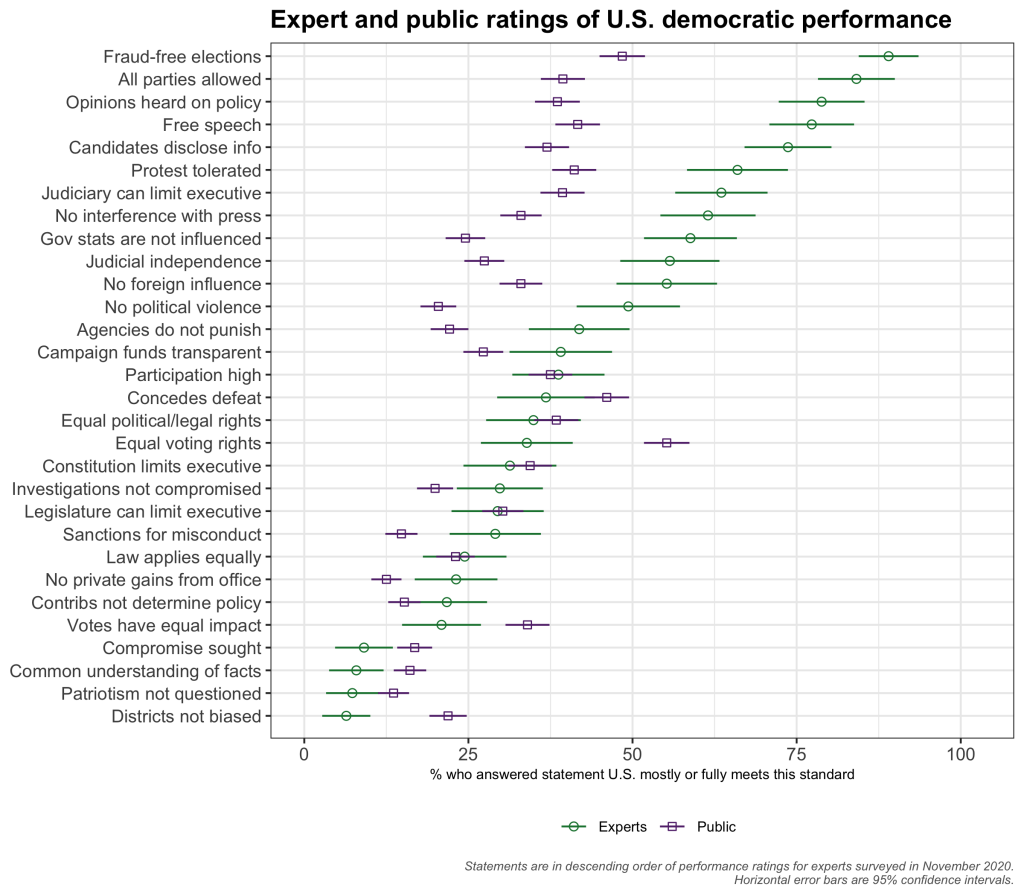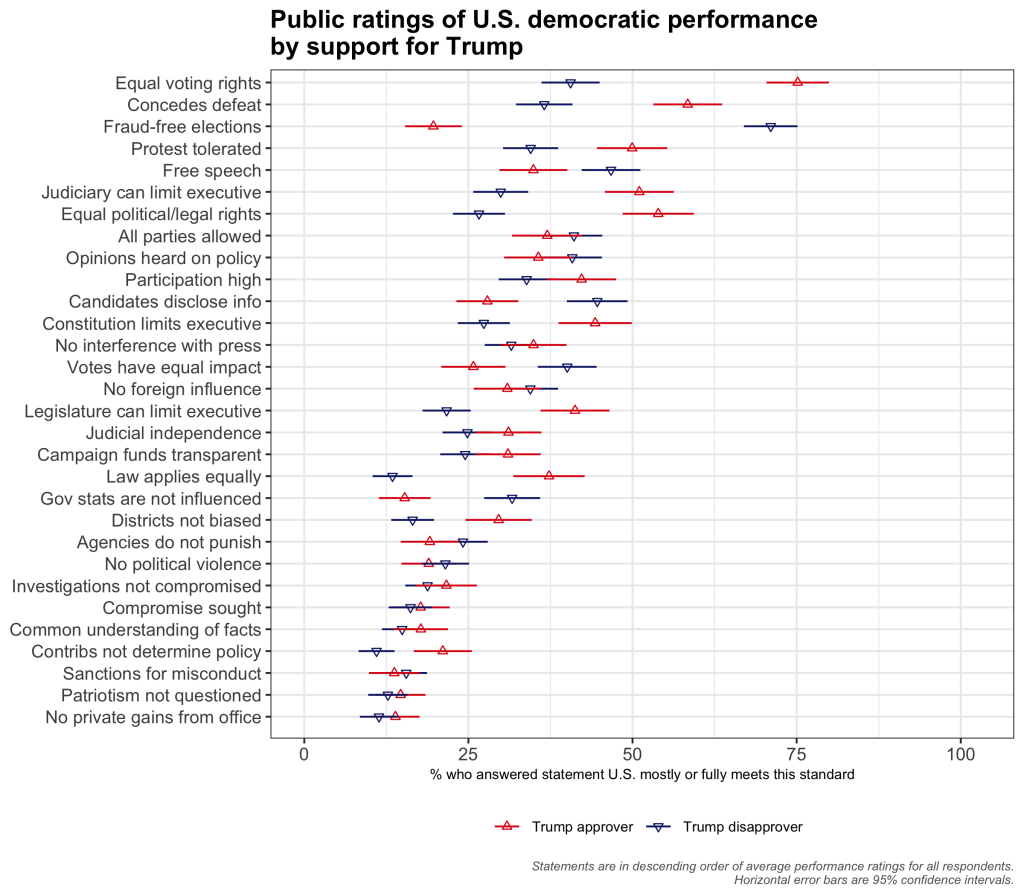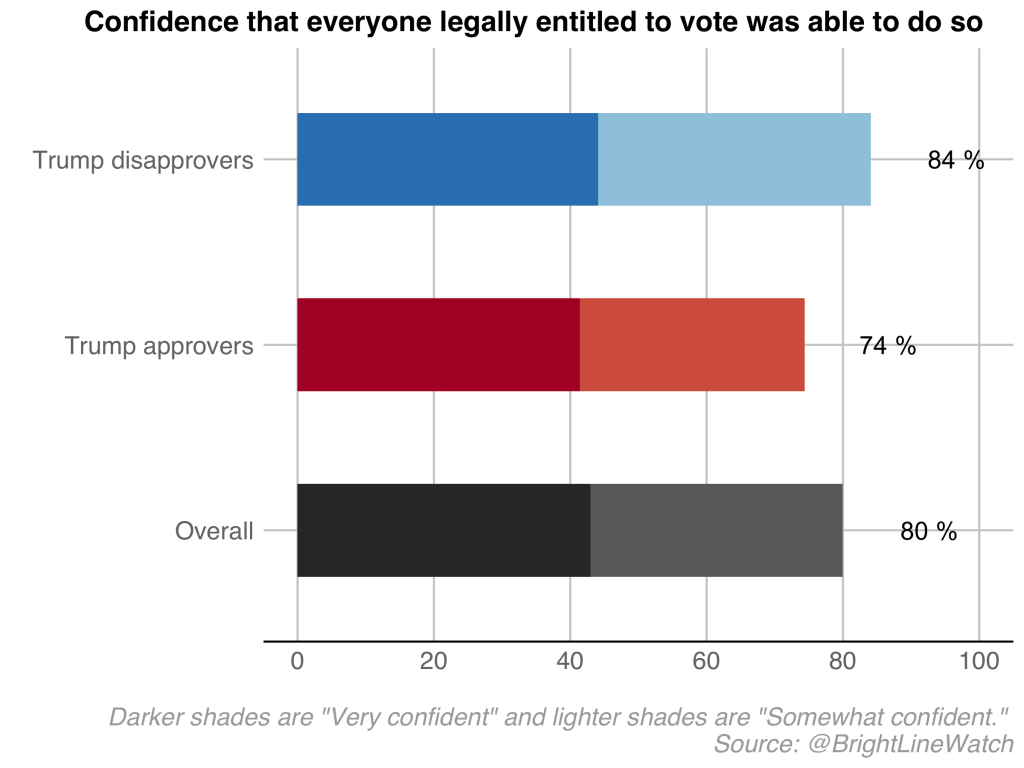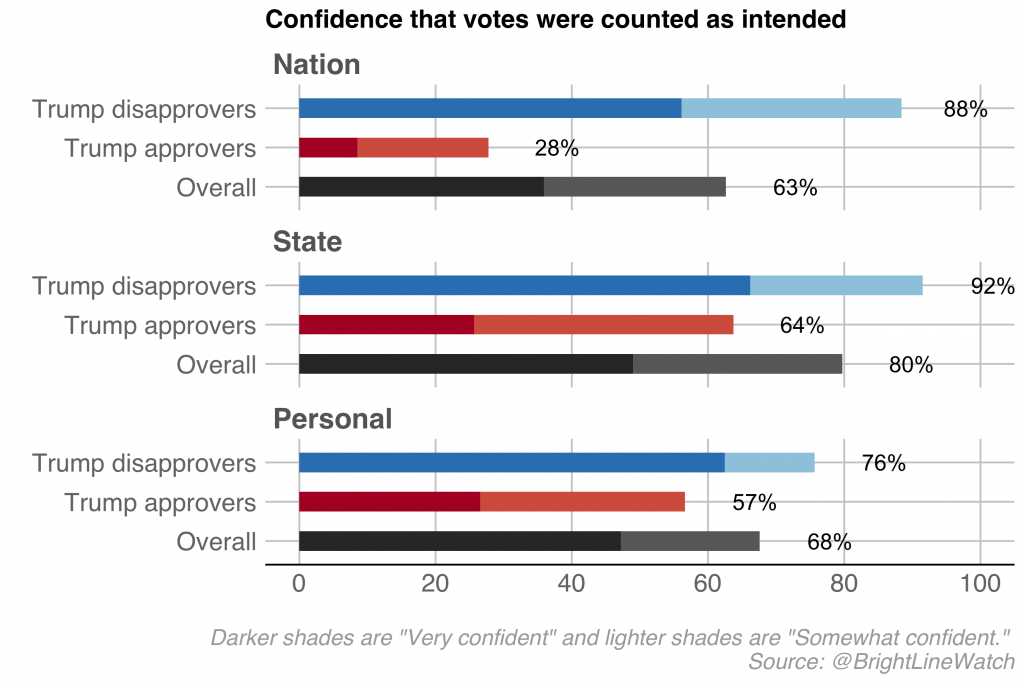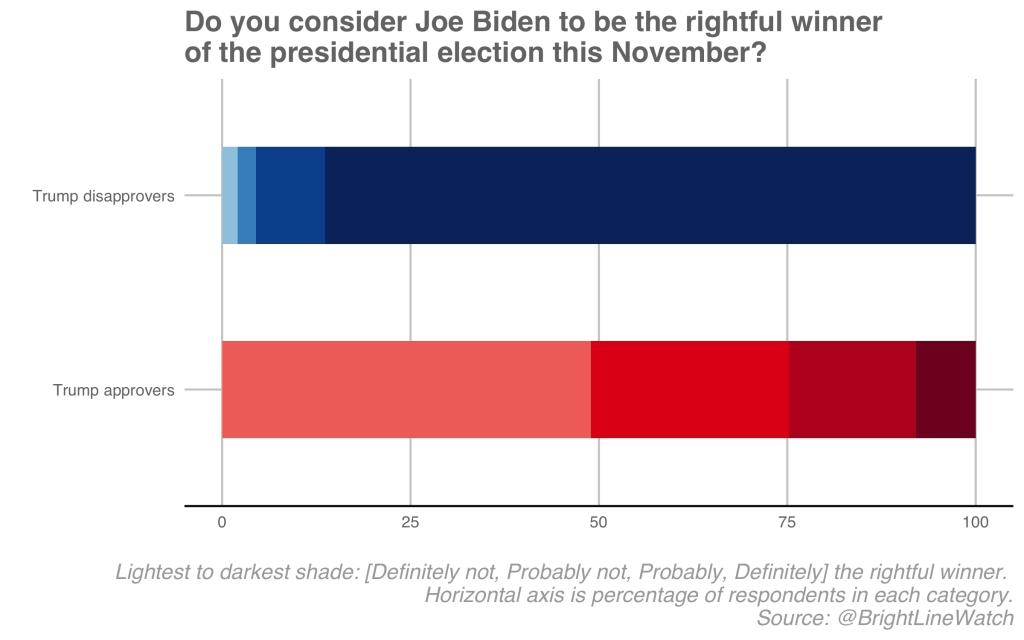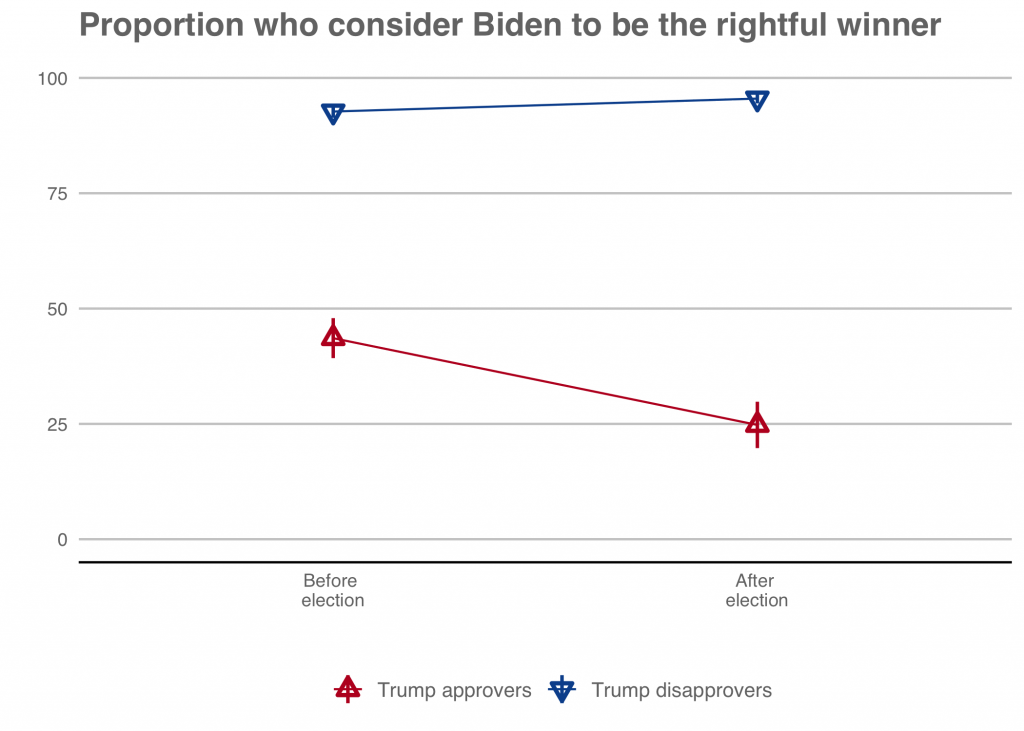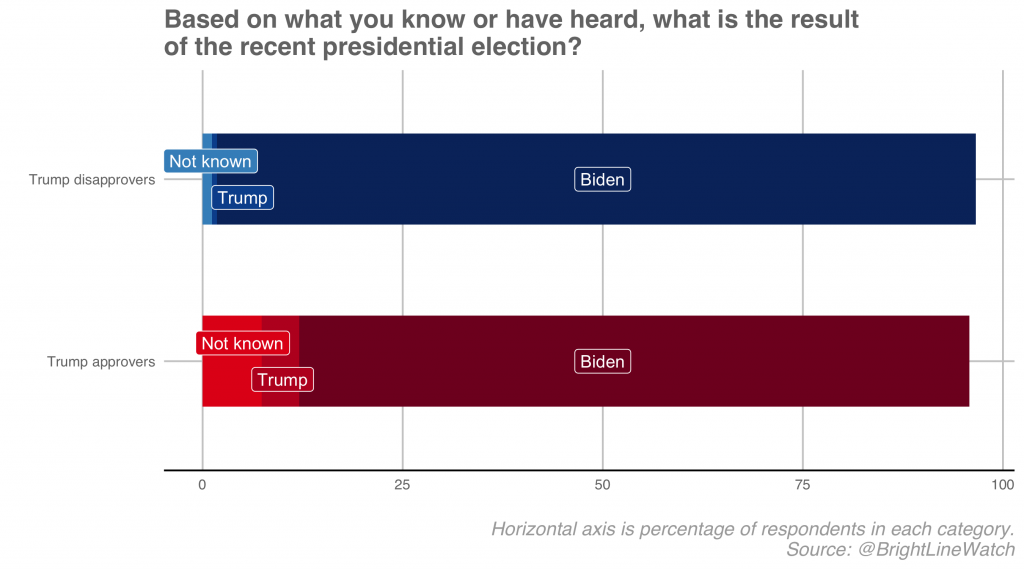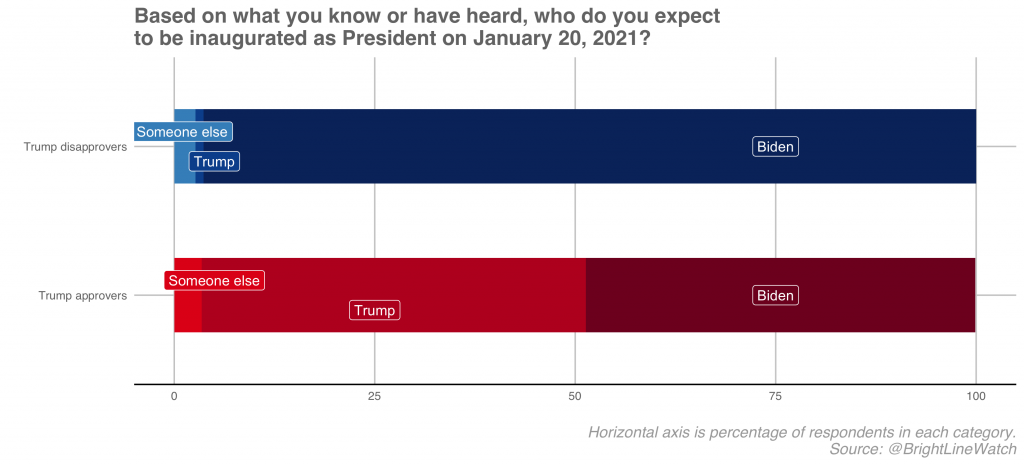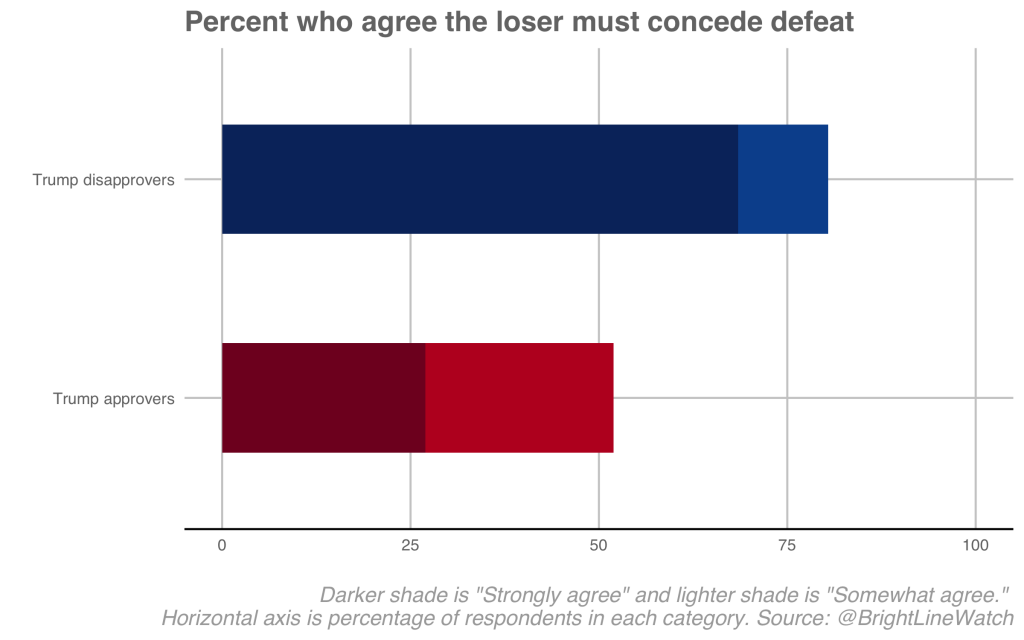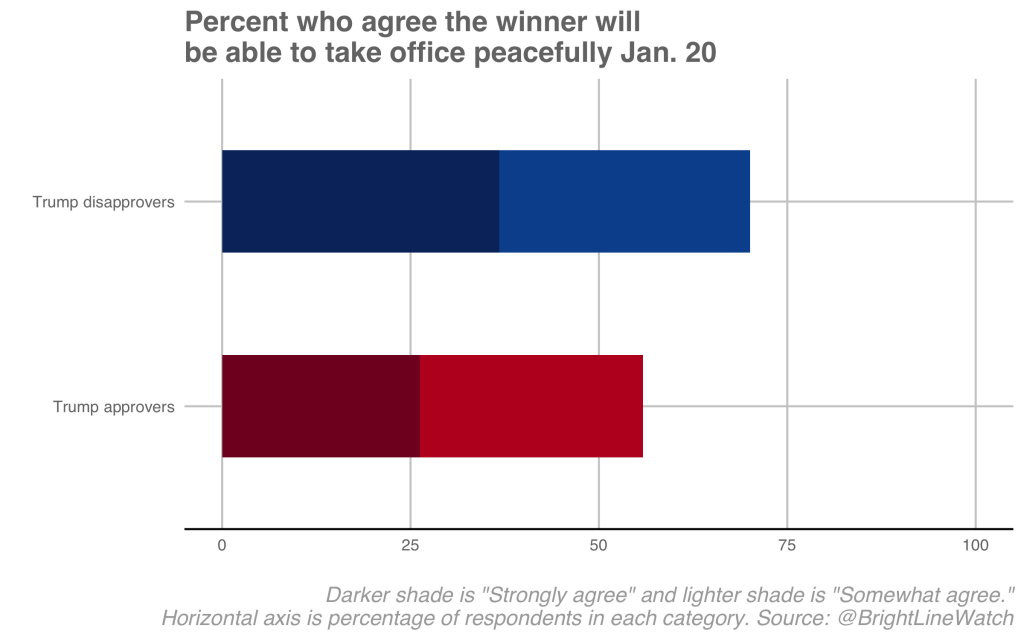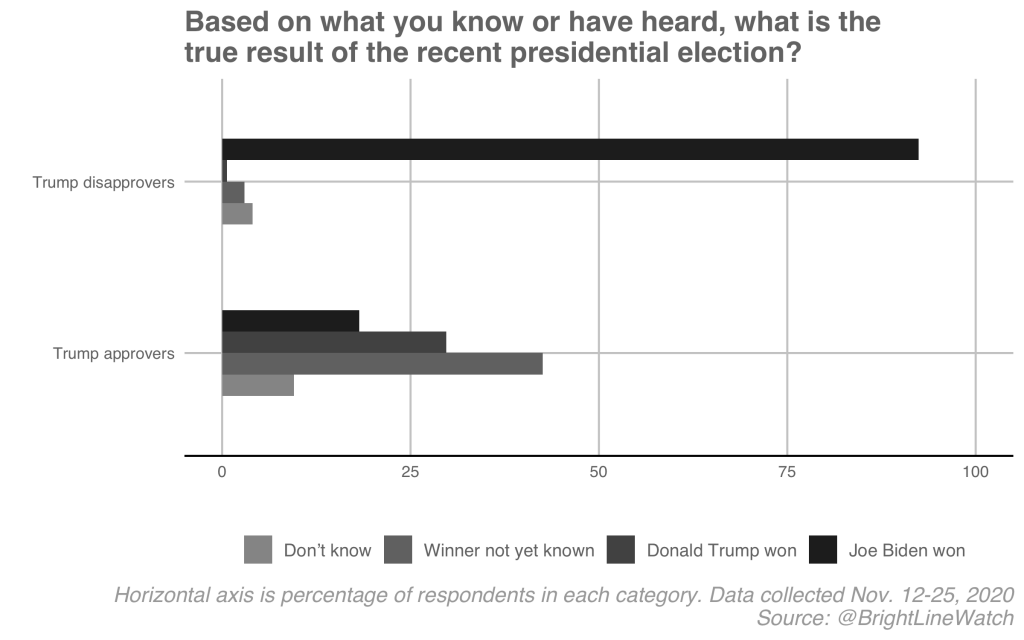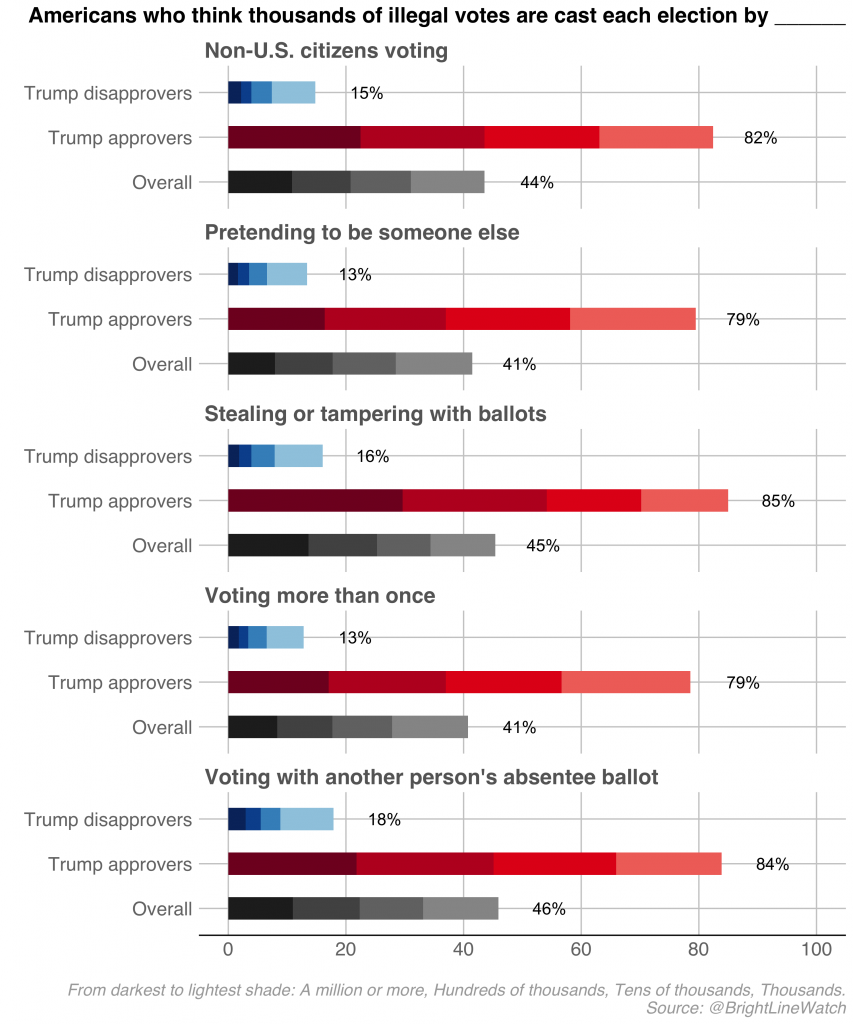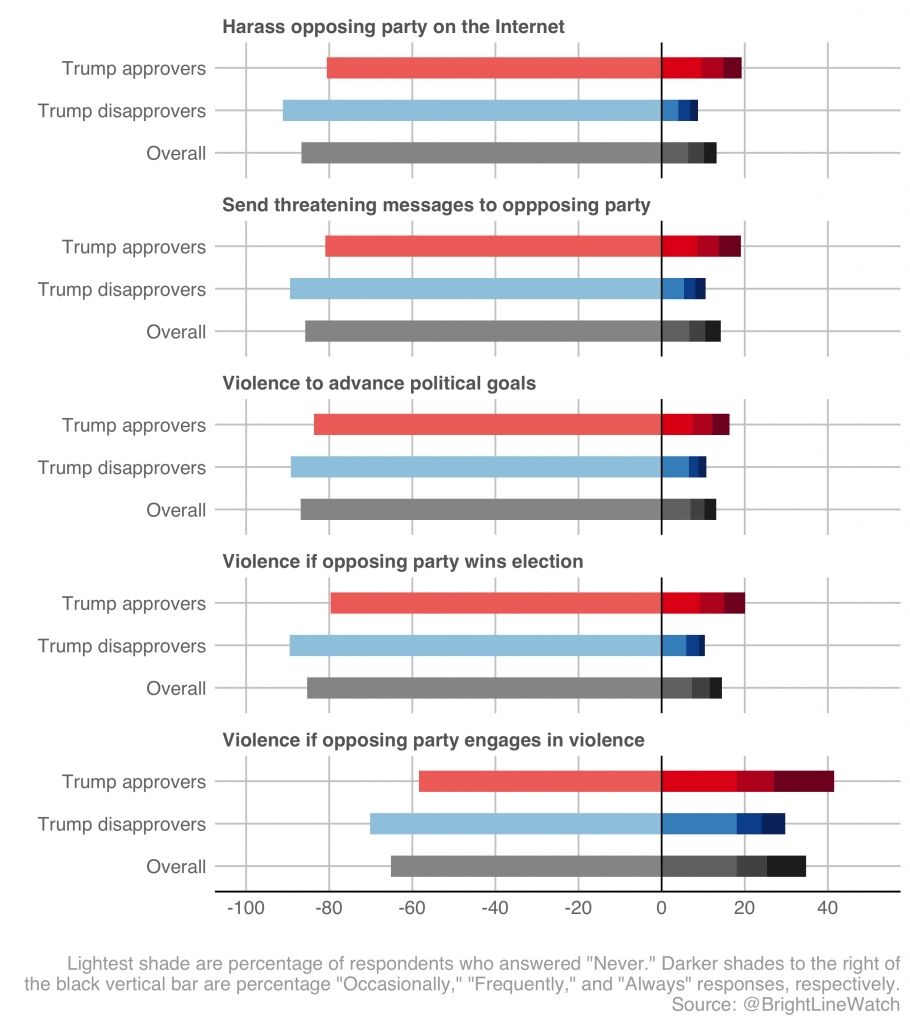A Democratic Stress Test — The 2020 Election and Its Aftermath
Bright Line Watch November 2020 surveys
The 2020 election and its aftermath presented severe challenges to U.S. democracy. The election was conducted during a pandemic that required fundamental changes in how Americans cast and counted ballots. The incumbent president refused to commit in advance to a peaceful transition of power if he lost, and continues to refuse to recognize that defeat as legitimate (though he has finally relented to letting the transition begin and signaled that he would accept an Electoral College defeat). During this process, many GOP leaders have endorsed the president’s baseless claims of electoral fraud, even publicly suggesting that state legislatures could override the popular vote in awarding electors. Yet the election ultimately succeeded in ways few dared hope. Most notably, polling places and mail balloting operated effectively and mostly uneventfully under unprecedented conditions. And despite a barrage of accusations and litigation, no evidence has surfaced of systematic malfeasance or mismanagement.
To assess the importance and consequences of these events, Bright Line Watch fielded parallel surveys of political science experts and of a representative sample of Americans to assess the importance and magnitudes of these events. In this post-election survey, which was fielded from November 12–25, we asked our public sample questions about the legitimacy of the election results, their confidence that votes were cast and counted fairly, their beliefs about voter fraud, and their willingness to condone political violence. We asked our experts to rate the likelihood of 23 scenarios related to the November election and the transition to a new administration that could produce political crises, and to evaluate a number of recent events related to the election. As in previous surveys, we asked both groups to assess the quality of U.S. democracy overall and to rate performance on 30 distinct democratic principles.
We report a number of key findings below from both the public and the experts we surveyed:
Public
-
Compared to before the election, confidence in the election process and the legitimacy of the outcome became much more polarized between supporters and opponents of President Trump.
-
Most notably, confidence in the national vote count plummeted among Trump supporters, declining from 56% before the election to 28% afterward.
-
Similarly, belief polarization about voter fraud grew still wider — in particular, even larger majorities of Trump supporters now believe that fraud is rampant compared to before the election.
-
More encouragingly, willingness to condone political violence declined slightly after the election.
Experts
-
Expert forecasts in October correctly identified the six nightmare scenarios that did actually transpire as among the eight that they forecast as most likely, but generally overestimated the probability of outcomes seen as somewhat or not very likely (none of which actually took place).
-
Experts believe it is highly likely that President Trump will continue to refuse to recognize Biden’s presidency and to obstruct the transition, and that the President will take actions to protect himself and those around him from legal exposure after leaving office. They regard problems with the Electoral College and the formal recognition of Biden’s presidency as unlikely.
-
Large majorities of experts regard Trump’s attacks on U.S. elections and the press as serious or grave threats to American democracy. By contrast, experts do not consider mail balloting to pose a threat to democracy and are divided over Amy Coney Barrett’s Supreme Court appointment.
We present our results in three parts. First, we review the public’s perception of various aspects of the November election. We then describe experts’ assessments of the election and events in its immediate wake. Finally, we step back to gauge how both the public and the experts rate the performance of American democracy both overall and across thirty core democratic principles.
The public’s view of the election
The November survey asked questions about a number of topics we previously asked about in October, including confidence in the election, beliefs about voter fraud, and attitudes toward political violence (the wording on some items was adjusted to be retrospective rather than prospective when necessary). We report here on the public’s views after the election and how they compare either for the full October and November samples or, in some cases, for the subset of respondents who took part in both surveys.
Legitimacy
We asked respondents in our public survey, which was conducted after the media called the race for Biden, if they regarded Joe Biden as the rightful winner of the presidential election. During the time that the survey was in the field, President Trump continued to press the case, without evidence, that elections in key states were marred by fraud, though he allowed the transition to begin just before the survey was completed and acknowledged the possibility of stepping aside if he loses the Electoral College vote soon after the survey was completed. We divide our respondents between those who approve and those who disapprove of Trump’s performance as president. Among those who disapprove, 86% regard Biden as definitely the rightful winner and another 9% regard him as probably the rightful winner. Among those who approve of Trump, the corresponding figures are just 8% and 17%, respectively. Similarly, just 18% of those who approve of Trump say the true result of the election was that Biden won; 30% said Trump won and 52% said the winner was not yet known or they didn’t know.
Partisan polarization over the legitimacy of the outcome was more severe than it appeared it would be in the October survey. In that earlier survey, we asked respondents to imagine a win by each major candidate. In October, 33% of survey respondents who strongly approved of Trump said they would view a victorious Biden as definitely or probably the “rightful winner.” After the election, only 9% of these same respondents said Biden was actually the rightful winner. Indeed, fully 67% of strong Trump supporters expressed certainty that Biden is definitely not the rightful winner.
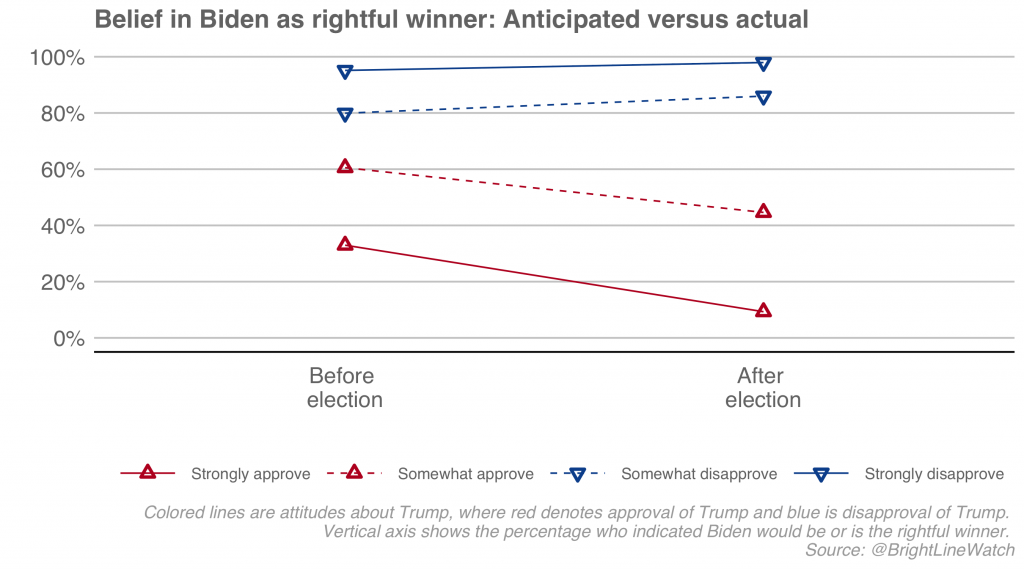
Differences in the perceptions of pro- and anti-Trump respondents are not the result of the two groups having different basic information about the election outcome. We asked each respondent to indicate whether they had heard that the media had declared a winner. Between 80% and 88% of each group had heard this news. We asked which candidate had been declared the winner. More than 8 in 10 Trump supporters acknowledged it was Biden (84%), not far behind the 95% of Trump opponents who knew this fact. Yet when we asked each group whom they believed would be inaugurated on January 20, 2021, nearly the same number of Trump supporters said they expected to see Trump sworn in for a second term (48%) than expected to see Biden take the oath (49%). Among Trump opponents, 96% expected Biden to be inaugurated.
Confidence in the ballot and the count
Our survey also probed what substantive beliefs underpin the suspicions among Trump supporters. We first asked public participants how confident they are that everyone who was legally entitled to vote and sought to do so was able to vote successfully. These differences are limited. Seventy-four percent of Trump supporters and 84% of Trump opponents said they were either very or somewhat confident that the franchise was open to all eligible voters (as opposed to not very or not at all confident). This gap narrowed since October; confidence in ballot access among Trump opponents increased from 65% to 84% (potentially reflecting record turnout and/or the election outcome), while falling among Trump supporters (from 85% to 74%).
Trump supporters and opponents differ most in their expressed levels of confidence in how votes were counted. We asked each respondent about confidence that their own vote was counted as intended, that votes in their state were counted as voters intended, and that votes nationwide were counted as voters intended. The figure below shows the levels of “very” and “somewhat confident” responses (as opposed to not very and not at all confident) among Trump approvers (red) and disapprovers (blue) in our pre-election and post-election surveys. Among Trump opponents, the proportion who expressed confidence that their vote was counted as intended is unchanged from October to November, but confidence at the state and national levels rose sharply (from 76% to 92% and from 61% to 88%, respectively). By contrast, confidence plummeted at all levels among Trump supporters over the same period. Confidence declined from 82% to 57% for the respondent’s own vote and from 77% to 64% in voting at the state level. Most notably, however, confidence in the national vote count collapsed from 56% to 28% among Trump supporters at the national level.
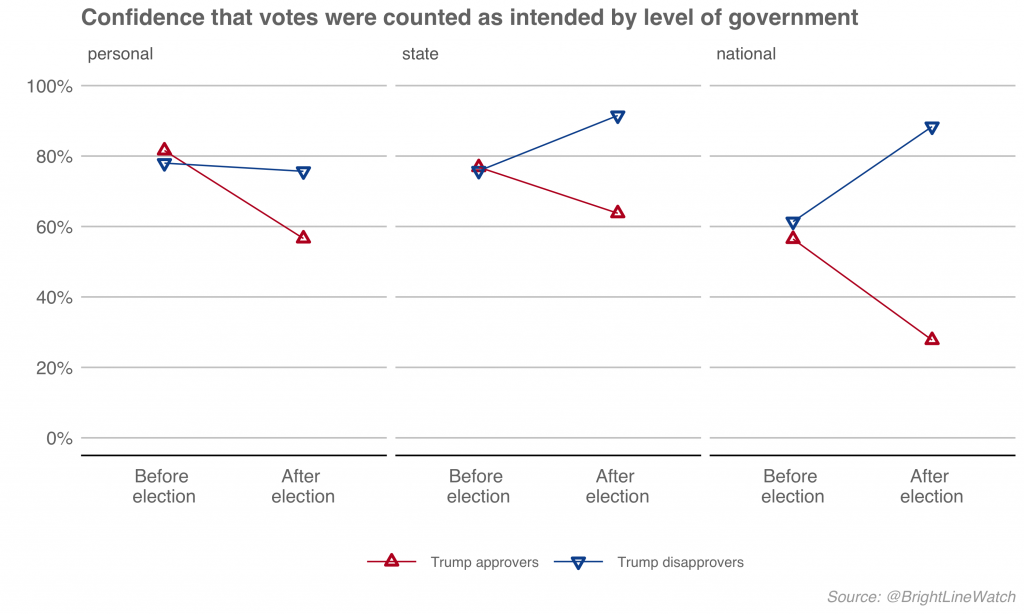
The figure below disaggregates respondents who took part in both surveys by their level of Trump approval or disapproval in October. The decline in confidence in the national vote was greatest among Trump’s most devoted supporters, who appear most receptive to messages from Trump and Republican elites questioning the integrity of the election outcome. Specifically, confidence in the national vote declined from 51% to 15% among people who strongly approved of Trump’s performance in office in October (versus 66% to 42% among those who somewhat approve). Among those who disapprove of Trump, confidence at state and national levels rose over the same period.
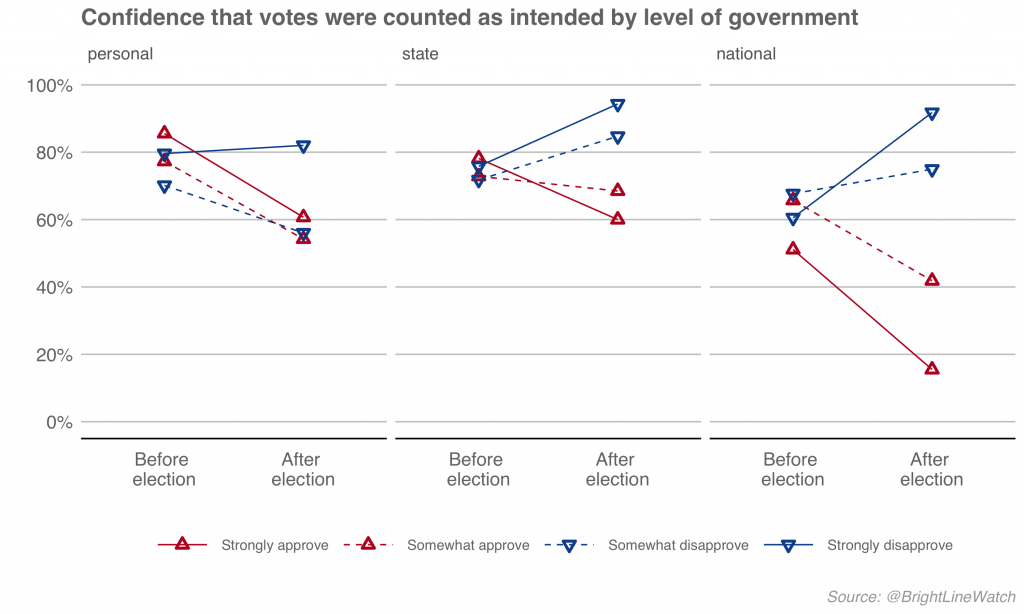
Incidence of voter fraud
If three-quarters of the president’s supporters do not believe national vote tallies, what do they regard as the source of mischief? President Trump has made baseless allegations throughout his presidency that American elections are marred by widespread fraud. Although voter fraud is vanishingly rare in general and no evidence has been presented of systematic fraud during the 2020 contest, false claims from the President and his allies appear to be affecting the beliefs of Trump supporters.
We asked respondents about the prevalence of five different forms of fraud: voting by non-citizens, voting under a false identity, stealing or tampering with ballots, voting more than once, and voting with another person’s absentee ballot. Respondents were asked, for each type of fraud, how many instances they believe occurred in the November election on a seven-point scale from “Less than ten” to “A million or more.” The figure below shows the percentage, among each group, that believes the incidence was “Thousands” or higher for each type of fraud.
Even among Trump opponents, perceived fraud was vastly more common than any documented evidence supports. Levels among Trump supporters are multiple times higher still — they were, for instance, more likely to select “Millions” than “Thousands” as a response option. Moreover, the gap in perceived fraud levels between Trump supporters and opponents only increased from October to November. Trump opponents perceived each type of fraud to be less frequent, while Trump supporters became more convinced of unbridled misconduct. (See Figure 11 in the appendix for partial distributions of responses for each item and group.)
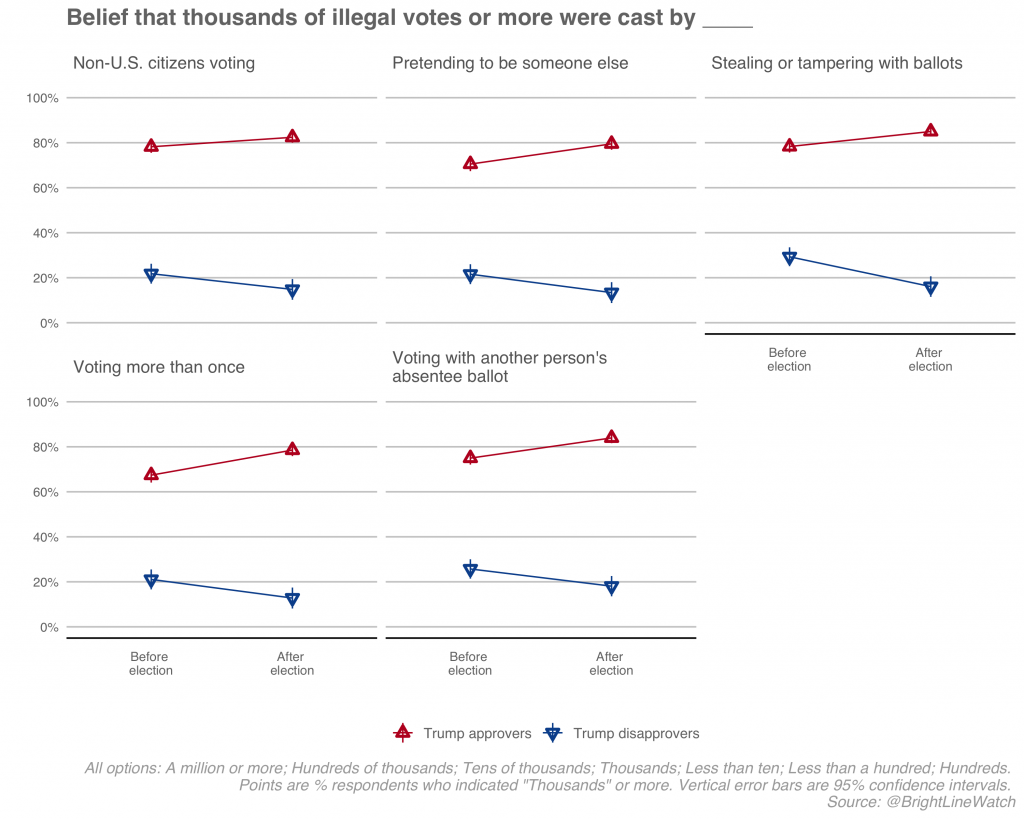
The figure makes clear that overwhelming majorities of Trump supporters — between 79% and 85% — regard every form of malfeasance we asked about as having occurred thousands of times or more (up to millions) in the 2020 election. The levels of fraud in which these respondents profess to believe are staggering and would require the complicity of thousands of local electoral officials and volunteers, including numerous Republicans and non-partisan participants. However, though claims of widespread fraud and electoral misconduct have been repeatedly dismissed by judges in Pennsylvania, Michigan, Nevada, Arizona, and Georgia, they have become pervasive among Trump supporters.
Tolerance for violence
Finally, we consider the public’s willingness to condone political violence and intimidation, a topic of widespread concern prior to the election, particularly after law enforcement foiled a plot by self-styled militia members to kidnap Michigan Governor Gretchen Whitmer in October. Thankfully, the November election itself went off without a major incident of violence. With the exception of confrontations at a Washington, DC rally between Trump supporters and his opponents that left one person hospitalized, celebrations and demonstrations following the declaration of Joe Biden as the winner were also largely peaceful. Following research by Nathan Kalmoe and Liliana Mason, we asked our respondents about whether it is ever justified to harass partisan opponents online, send a threatening message to an opposing party leader, use violence to advance one’s goals, use violence in response to violence from the other party after the election, or use violence if the other party wins the next election.
Here, we find a bit of good news — willingness to condone intimidation and violence declined from October to November. The magnitudes of these declines were modest but they were statistically discernible from zero for every item in the survey battery among President Trump’s opponents and for 2 of 5 items (“Violence if the opposing party wins an election” and “Violence to advance political goals”) among Trump supporters. The figure below shows slight decreases in the percentage of respondents who say that they would occasionally, frequently, or always resort to violence in each scenario (the residual category was “never”). The experience of a relatively peaceful election appears to have reduced perceptions of threat from partisan adversaries.
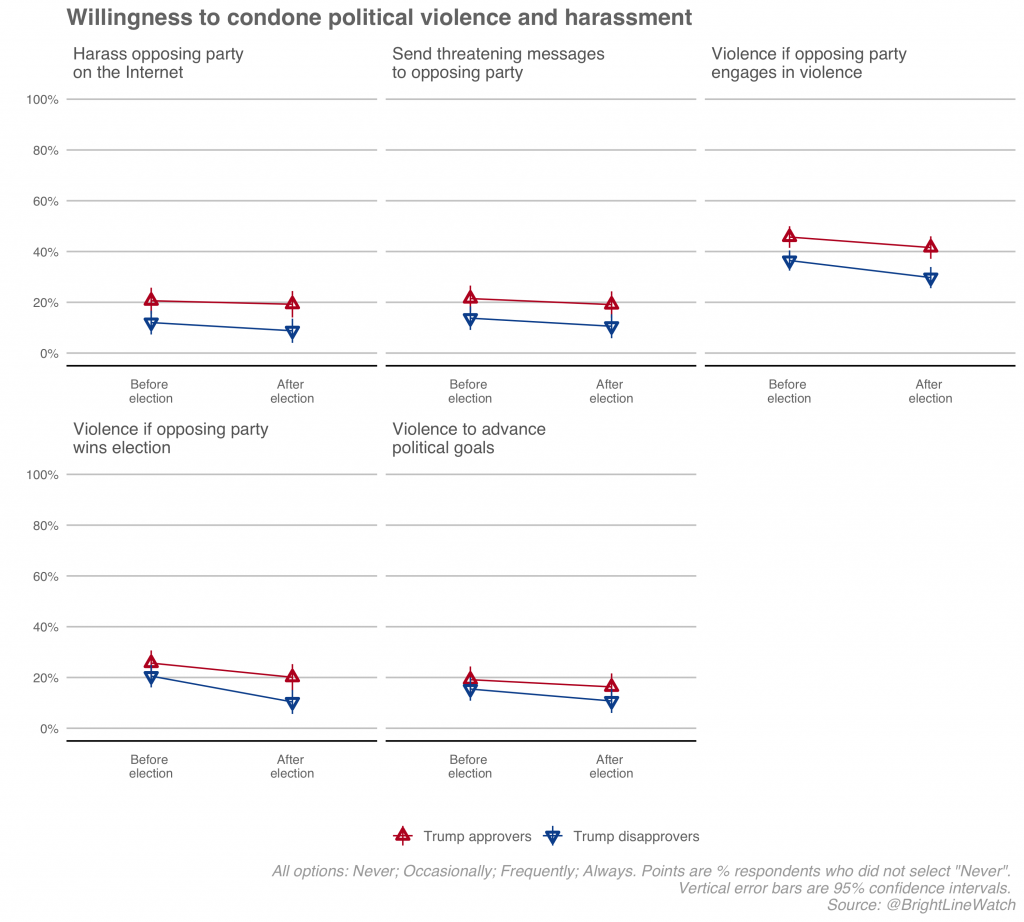
Experts’ views
We asked our expert sample to evaluate the likelihood of a number of prospective scenarios frequently discussed in the media, and to assess events that have already happened according to their normality, their importance, and the potential threats they present to American democracy.
Nightmares that happened, that did not, and that could loom ahead
Both the October and November surveys asked our experts to estimate the probability of election-related scenarios that could create crises for democratic institutions. We asked them about 28 distinct scenarios. In October, there were eight nightmare scenarios on which the median expert forecast was 70% or higher (i.e., experts thought there was at least a 7 in 10 chance the event would occur):
-
Millions of Americans are exposed to false claims about voter fraud and election integrity on social media from unknown or obscure sources on Election Day (95%).
-
President Trump attacks the “blue shift” toward Democrats as mail votes are counted, insisting that the initial totals on Election Night were correct (85%).
-
Tens of thousands of voters are still in line when polls are scheduled to close in at least one state due to long lines and delays on Election Day (84%).
-
President Trump makes statements or posts tweets encouraging violence and intimidation during voting or ballot counting (81%).
-
President Trump is declared the loser of the election by the Associated Press but refuses to immediately concede defeat (80%).
-
One or both presidential candidates declare victory before the race has been called by the Associated Press (70%).
-
Interim Election Night totals understate Democratic votes, creating widespread suspicion of the results (70%).
-
5% or more of ballots cast by mail are rejected in one or more states (70%).
Of those projections, the two predicting election administration failures were clearly incorrect. Polling places operated with remarkable effectiveness; expectations about long lines and delays for voters did not materialize. Similarly, rates of mail-in ballot rejection were lower than in previous elections, generally at or below one percent and never exceeding the five percent threshold in any state that many experts feared. The other six high-likelihood nightmare scenarios did, in fact, materialize. President Trump encouraged his supporters to engage in tactics that could intimidate other voters and vote counters, then declared victory on Election Night. Election Night vote totals understated Democratic support, Trump insisted vote counting should stop, Trump was declared the loser but refused (and still refuses) to concede, and false claims about voter fraud and election integrity have flooded social media on and after Election Day.
None of the other twenty scenarios have taken place to this point. These were scenarios which, on average, experts rated as having a probability of taking place that was as low as five percent or as high as 64%. (Our prior report indicated that these probabilities seemed too high; see its appendix for the full list.) Of these, seven did not take place as specified, including scenarios experts rated as quite possible, such as the Department of Justice seeking to block the counting of mail-in ballots (55%), postal service delays causing more than one million mail ballots sent by voters to not be delivered in time to be counted (50%), or poll-worker shortages forcing the Election Day closure or consolidation of more than one thousand polling locations nationwide (50%). Experts were appropriately skeptical of other scenarios that did not take place, including millions of counterfeit ballots being mailed to Americans from a foreign county (5%), the RNC or DNC selecting a replacement candidate for president before Election Day (10%), stay-at-home orders preventing voters from going to the polls on Election Day in one or more large cities (20%), or Russian hackers crippling voter registration and election systems in one or more states (22%). (Thirteen other scenarios that experts rated in the prior wave remain possible, though most appear exceedingly unlikely.)
The overall results of expert forecasts are summarized in the figure below, which indicates that experts performed relatively well among events they rated as having a high likelihood of taking place (six of eight events took place that they rated as having a 70% chance or better). However, seven other events that they predicted as having a 5–55% chance of taking place did not occur.
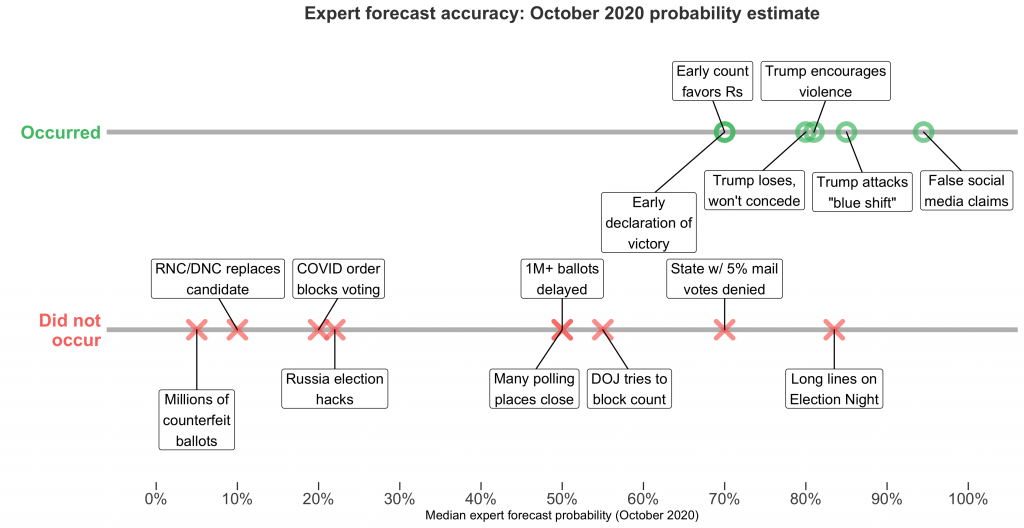
Our November expert survey included 23 nightmare scenarios — nine repeated from the October survey that could still occur and others that we introduced as options on this November survey for the first time. The full list of scenarios evaluated in this wave is available in the appendix. The next figure below reports the median probability estimate and density of expert probability estimates across the 0–100% range for each scenario. Items are listed in descending order of estimated median likelihood. The experts rate twelve scenarios as more likely than not; the other eleven are regarded as substantially less likely, with median estimates of 35% or lower. The probability distributions are shaded red for high-probability items and yellow for those rated less likely.
According to experts, the most likely events on the list are President Trump refusing to attend President-elect Biden’s inauguration (90% median probability estimate) or to concede the election before that date (84%). By contrast, they view a scenario in which Senate Leader Mitch McConnell and House Minority Leader Kevin McCarthy refuse to acknowledge Biden’s electoral win as far less likely (20%).
At the time of our survey, our experts expected Trump to obstruct a smooth transfer of authority, including blocking funding for Biden’s transition team until the Electoral College vote or afterward (80%), refusing to cooperate with the transition until the Electoral College vote or afterward (78%), and firing over 100 senior civil servants (60%). The administration did in fact block funding and authorization for the transition for three weeks after the election, but relented on that count only on November 23 rather than pressing the matter until the Electoral College vote.
The experts were also attuned to the legal precarity of President Trump and those around him, rating as likely that the president destroys incriminating documents before leaving the White House (82%); uses the pardon power preemptively on behalf of Rudi Giuliani (80%), members of his own family (74%), or even himself (56%); pardons or commutes the sentences of political allies Michael Flynn and/or Paul Manafort (80%), and seeks legal amnesty for himself and family members (70%). Here again, just as our survey completed, Trump validated one of these forecasts by pardoning Michael Flynn on November 25. Another pardon scenario was rated as much less likely by our experts, however — the median forecast for President Trump resigning before January 20 and then being pardoned by Mike Pence is only 27%.
Various scenarios associated with indeterminate and contested election outcomes are now seen as unlikely by experts. The highest probabilities were assigned to the Supreme Court intervening to decide one or more election-related disputes (35%) or one or more states failing to appoint electors before the December 8 safe harbor deadline (25%). Less likely still are scenarios in which one or more states send competing slates of electors to Congress (15%) or one or more state legislatures abandon the popular vote as a basis to appoint electors (10%).
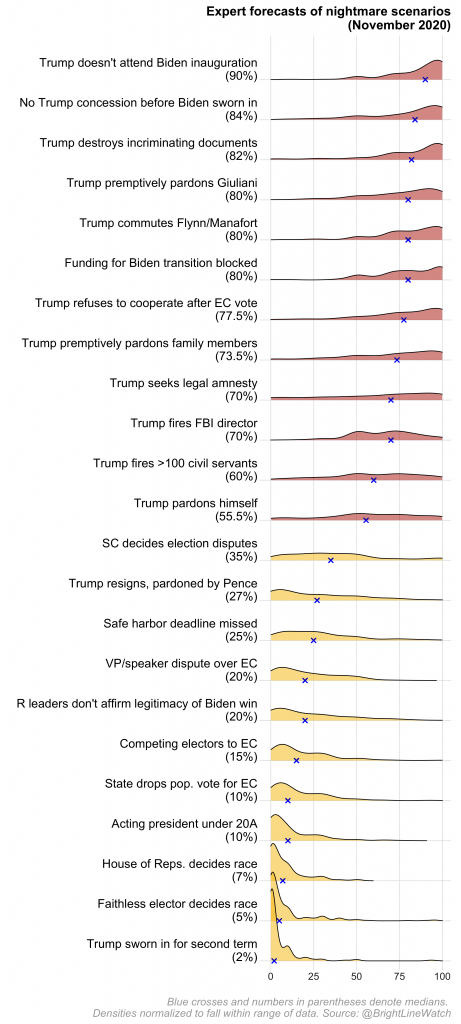
Scenarios involving Electoral College indeterminacy — a dispute between the Vice President and Speaker of the House, the appointment of an acting president, the determination of the presidency by the House of Representatives, or pivotal action by a faithless elector — are rated as even less likely. The least likely of our 23 scenarios, however, is Trump being sworn in for a second term, which gets a median probability of 2%.
A clear pattern emerges from these responses. The experts expect non-compliance from President Trump in the orderly transfer of authority to a Biden administration. They expect legal machinations around the pardon authority and possible amnesty for at least members of the Trump family and inner circle. They do not, however, regard Joe Biden’s victory or his eventual path to the presidency to be in serious doubt. Based on the pattern from October, we expect a number of the scenarios rated as most likely by experts to take place but relatively few of those rated as having a low or intermediate probability.
We repeated nine of the 28 nightmare scenarios from the October survey in November. Most of these scenarios refer to aspects of the process by which the state-level popular vote is converted into a presidential election outcome — for example, a state missing the safe harbor deadline for selecting its presidential electors on December 8 or sending competing slates of electors to Congress later in the month. On the whole, our experts’ sense of alarm about the election has declined, with probability estimates for every election-related item declining between our October and November surveys. The figure below shows the median estimate and 95% confidence interval for each scenario in declining order of their estimated likelihood.
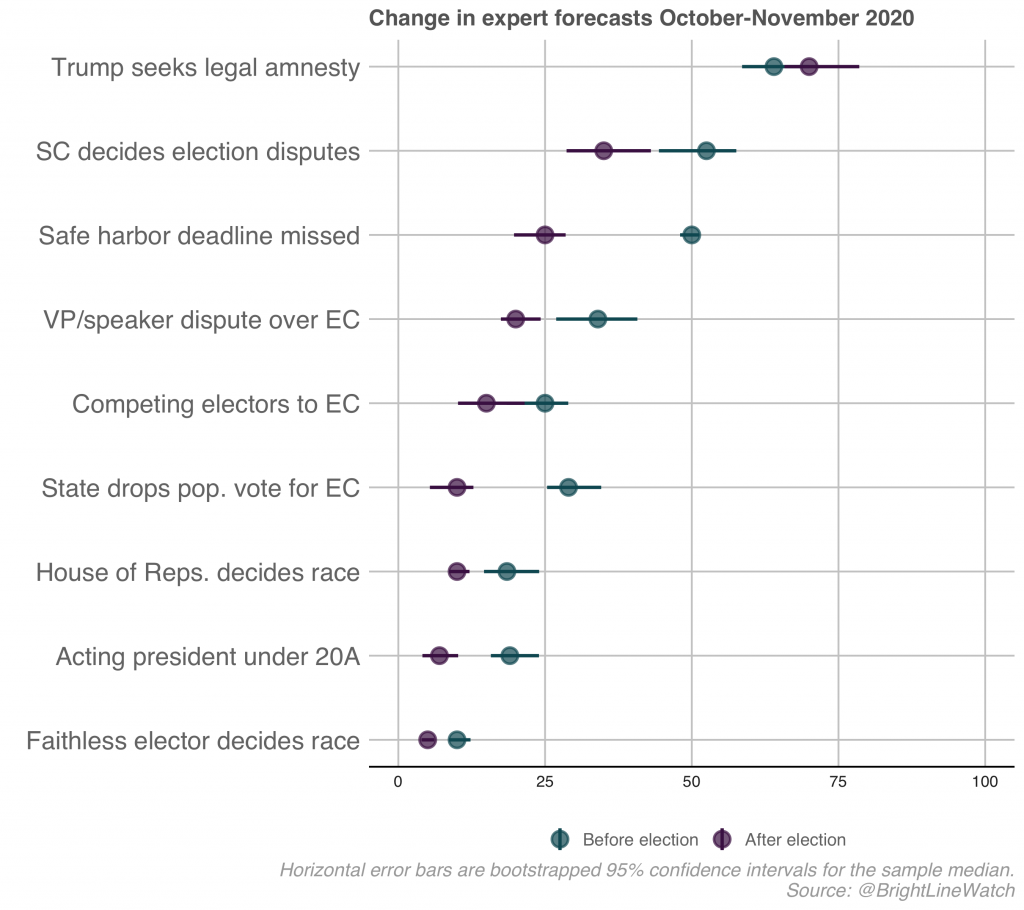
Concern among experts declined in almost every case, including that the Supreme Court would intervene to resolve an election dispute (53% to 35%), that a state would miss the safe harbor deadline (50% to 25%), that a state would abandon the popular vote as the basis for naming its electors (29% to 10%), or that an acting president would be appointed under the 20th Amendment (19% to 10%). The only item that does not decline from October to November relates to President Trump’s legal status. Expert expectations that Trump would seek legal amnesty for himself and family members during the transition rose slightly from 64% in our October pre-election survey to 70% in the post-election survey.
Threats to democracy
Our November survey included a new battery that asked the experts to gauge the threat, if any, to American democracy posed by ten noteworthy events. Respondents were asked to rate each event as a grave threat, a serious threat, a moderate threat, little threat, or no threat to democracy. The bar graph below lists the events in order of the total proportion of experts that rated each threat as either grave (red), serious (orange), or moderate (yellow).
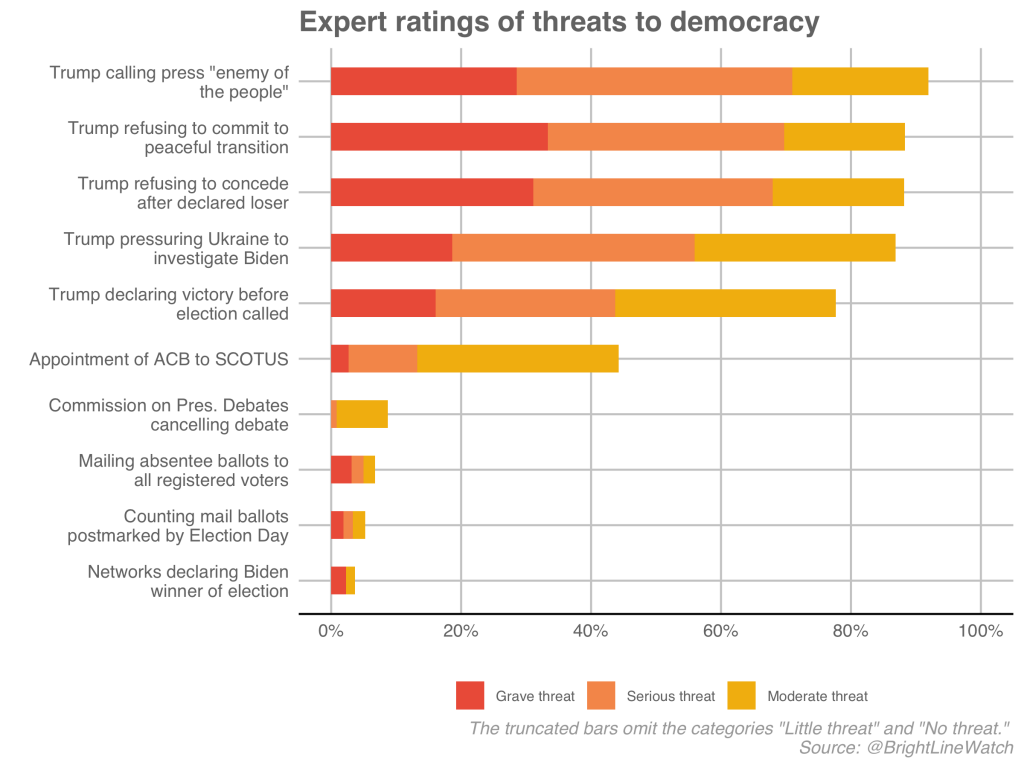
Despite bitter criticism from the Trump administration, experts do not regard media outlets declaring Biden the winner of the election as a peril to democracy. Similarly, few see distributing mail ballots to all registered voters in some states or counting them if mailed by election day as threats. Although unprecedented, few experts regard the cancellation of a presidential debate as a hazard to our system of government either. All of these events were decried by Trump, but experts perceive little or no threat.
The appointment of Amy Coney Barrett to the Supreme Court raised somewhat greater alarm among experts. Barrett’s nomination and confirmation in the last weeks before the election attracted howls from President Trump’s opponents, who denounced the move as a power grab and constitutional hardball. The appointment spurred calls for Supreme Court expansion among Democrats anticipating that the election would return control of the Senate as well as the presidency. Despite this outcry, however, most experts were not seriously concerned over Barrett’s appointment — 55% rated it as posing little or no danger to democracy, though 31% rate it as a moderate threat, 11% as a serious threat, and 3% as a grave threat.
The events that experts saw as more threatening to democracy all pertain to President Trump’s conduct in office. Some predate the election. For instance, we asked experts to rate Trump’s July 2019 attempt to pressure Ukrainian President Vlodymyr Zelensky into investigating Joe Biden. Nineteen percent rated that event, which prompted Trump’s impeachment by the House of Representatives, as a grave threat to democracy, while 37% regarded it as a serious threat and 31% rated it as a moderate threat. Experts were most alarmed, however, by Trump calling the press an “enemy of the people,” an epithet he has repeated throughout his presidency. Seventy-one percent of experts described Trump’s use of this smear as a grave or serious threat to democracy. These figures were nearly identical to those for Trump’s refusal to commit to a peaceful transition of power (70% of experts rated as grave or serious) and his related refusal to concede after Biden was projected to be the winner (68% grave or serious). These judgments reflect an expert consensus that freedom of the press and the peaceful transfer of power via elections are bedrocks of democracy; Trump’s refusal to honor these principles is seen to place that foundation in jeopardy.
The importance and normality of events in October and November 2020
As in prior surveys, we asked our experts to separately assess the importance and normalcy of notable events that took place since our last report. Although our previous survey was conducted only one month earlier, there was no lack of material. Results are presented in the figures below. The events of greatest concern are those situated in the upper-right quadrant. These events are ones that experts deem highly unconventional and consequential; these are often major departures from democratic norms.
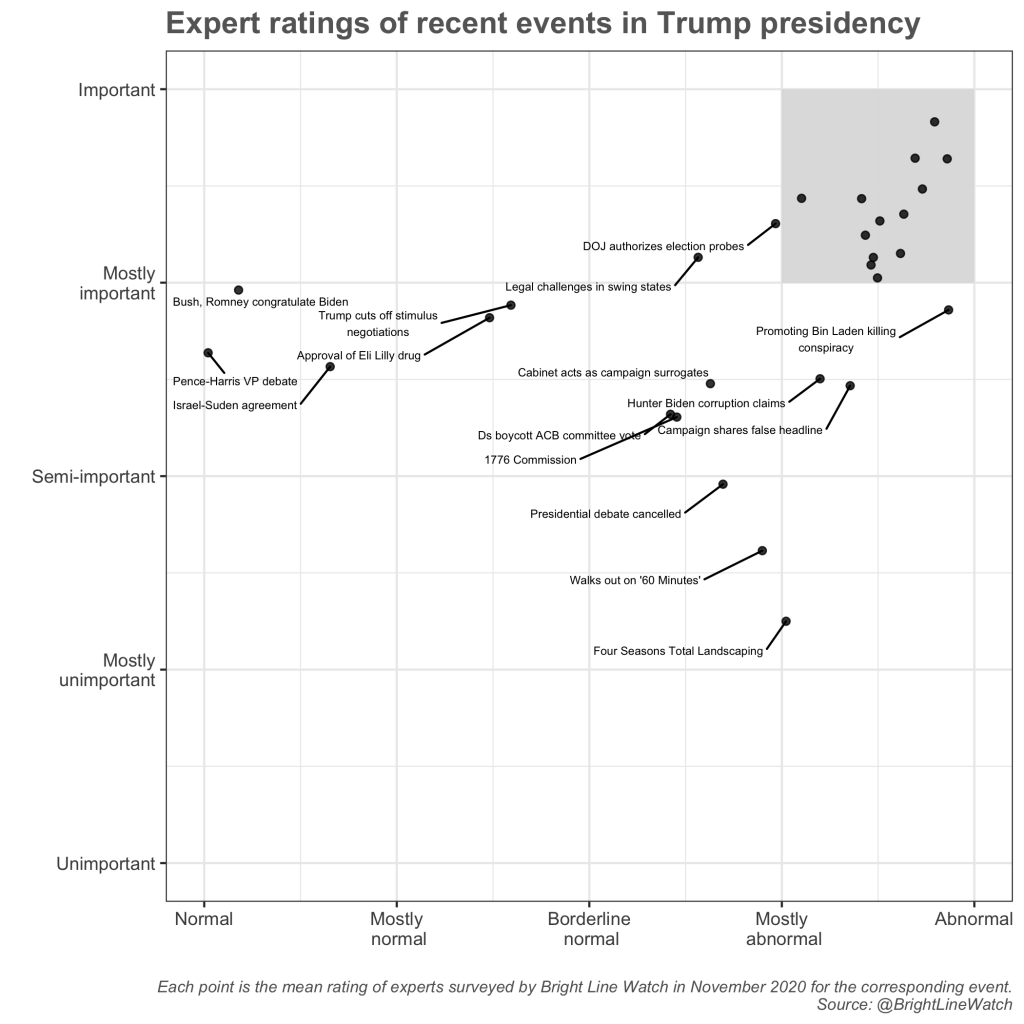
To provide greater clarity, the figure below provides a magnification of the top right sector highlighted in gray above, labeling the densely clustered items (labels in black) and superimposing them over items rated in that same top right sector in previous survey waves. These are the events that took place during the Trump administration that experts rated as most abnormal and important.
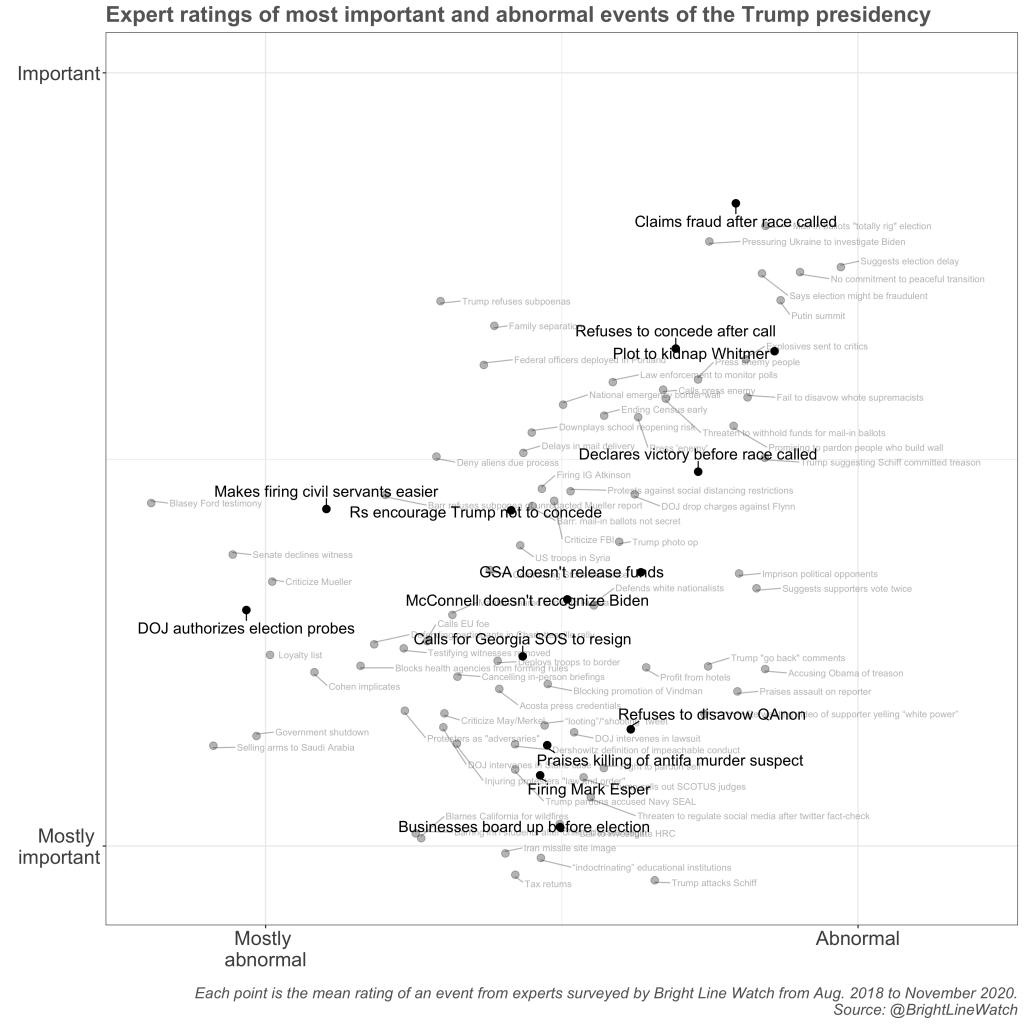
None of the events from October and November broke ground in their abnormality alone. The most abnormal events to date in our data include Trump’s suggestion of a delay in the 2020 election; his refusal to commit to a peaceful transition of power; and the Helsinki summit in which Trump sided with Russian President Vladimir Putin in rejecting U.S. intelligence of Russia’s interference in the 2016 election. However, experts rate President Trump’s persistent claims of widespread election fraud after the presidential election was called for Biden as the most important event of his presidency that is also highly abnormal. Here again, our expert responses highlight the premium they place on consensus recognition of core democratic procedures and electoral authority. The way Trump is using baseless claims of fraud to deny the legitimacy of his defeat in a free and fair election presents a direct threat to democratic stability.
Democratic performance as evaluated by the public and the experts
As in previous surveys, we asked both expert and public respondents to assess the quality of U.S. democracy overall and to evaluate its performance on thirty distinct democratic principles (see Appendix for the complete list). The figure below shows mean evaluations of the overall quality of U.S. democracy on a 0–100 scale among experts (green line) and the public (purple line). It also separately plots responses among the public from Trump approvers (red line) and disapprovers (blue line).
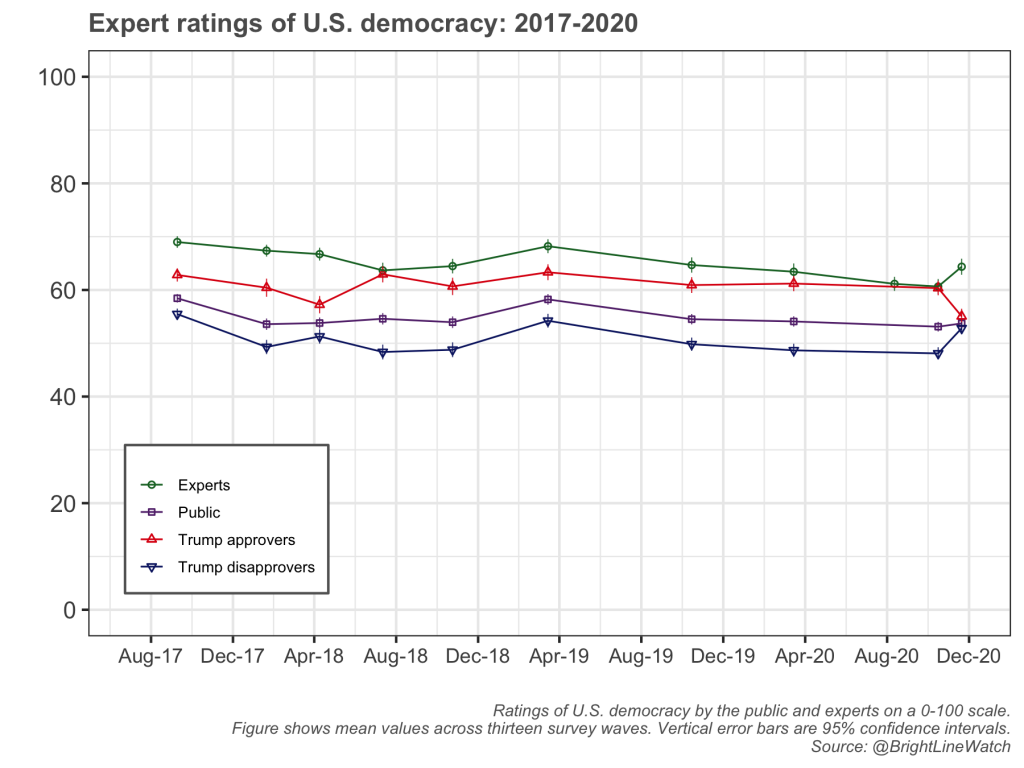
The 2020 election improved perceptions of U.S. democracy among both the public and experts. The mean rating on a 0–100 scale nudged up from 53.1 to 53.7 among the public from October to November and from 60.6 to 64.4 among experts. Unsurprisingly, though, this pattern differed sharply between members of the public who approve of Trump and those who do not. Trump supporters rated U.S. democracy lower (declining from 60.4 to 55.1) while opponents rated it higher (increasing from 48.1 to 52.8).
The next figures turn attention to our thirty democratic principles, showing the percentage of respondents who indicated that the U.S. “mostly meets” or “fully meets” each principle in our October (left side) and November (right side) surveys. The lines illustrate changes from one survey to the next, with statistically significant improvements highlighted in green and declines in red.
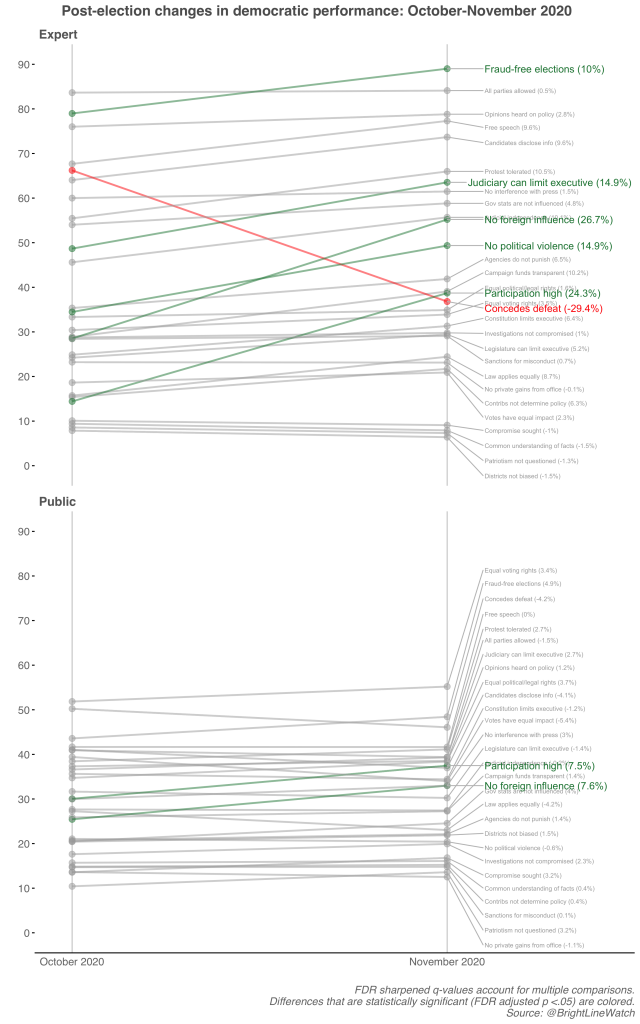
Among experts, we see a measurable decline in democratic performance on only one principle — that politicians who lose free and fair elections will concede defeat — and sharp upticks on some principles related to elections, including elections being free from foreign influence (from 29% to 55%) and participation levels being high (from 14% to 39%). November’s survey also saw a substantial improvement in expert assessments that citizens are protected from political violence by private actors, which may reflect the lack of violence surrounding the November election as well as a rebound from the October survey, which followed shootings at protests in Wisconsin and Oregon earlier in the fall.
Among the public, evaluations of performance on democratic principles were relatively stable. We observe significant changes from October to November on only two items — that participation should be high and elections protected from foreign influence. Assessments improved on both principles. Positive evaluations of US performance on participation comes in the wake of the highest turnout in more than a century, with an estimated 66.5% of eligible voters casting ballots. The improved assessment on foreign influence reflects pre-election concerns not being borne out.
When we separate public respondents by approval of President Trump in the figure below, however, the picture changes radically. Trump supporters perceive measurable declines on seven items: protections for free speech, individuals’ right to protest, and from foreign influence in elections, that candidates disclose sufficient information for voters to know how they will govern, that electoral districts do not systematically favor one party, that all votes have equal impact, and that elections are free of fraud. The last claim likely indicates that President Trump’s stream of claims about electoral fraud are resonating with his supporters, despite the failure of the president and his legal team to provide any evidence that withstands judicial scrutiny.
We find a steep drop in Trump approvers’ belief in all votes being counted equally, from 62% in October to 28% in November. This drop is puzzling. It is well documented, of course, that all votes do not count equally. Votes from less-populated states are, in effect, more heavily weighted both in presidential elections via the Electoral College and in the Senate because of that chamber’s malapportionment. In House elections, Republicans are advantaged in more states by gerrymandering than are Democrats and enjoy structural advantages in districting due to greater geographic concentration among Democrats. As a result, Republicans enjoy success that is disproportionate to their vote share in contests for every federal office. The president’s supporters are presumably not embracing these facts but instead expressing dissatisfaction that their votes were not enough to keep Trump in the White House.
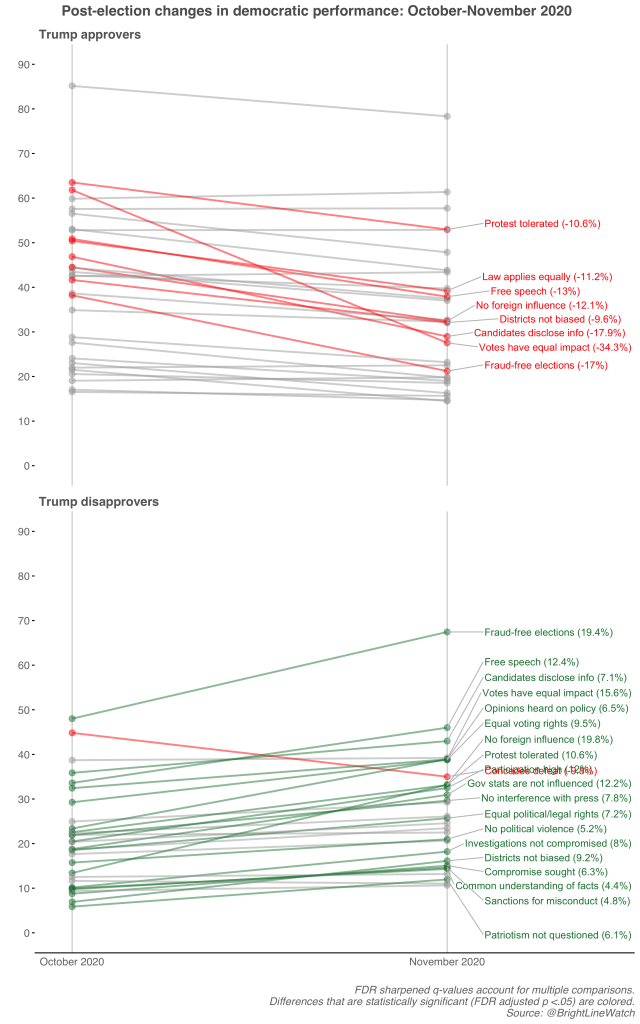
The picture among Trump’s opponents looks dramatically different. Like the experts, they perceive a decline in democratic performance on one principle — that losing candidates concede elections — but on 19 of the remaining 29 items their assessments rose by statistically significant margins. The greatest improvements were observed for confidence that elections are free of fraud, which rose more (19 percentage points) than perceived performance on the same item declined among Trump supporters (17 points). The list of other items in which performance increased significantly includes those connected to elections (equal voting rights, equal impact, no foreign influence) and also some that pertain to norms of behavior (seeking compromise with opponents, respecting one’s adversary’s patriotism). In general, Trump’s opponents viewed U.S. performance on numerous democratic principles more positively in the weeks following the election.
Appendix
Bright Line Watch surveys on the state of America’s democracy, November 2020
From November 12–25, 2020, Bright Line Watch conducted its thirteenth survey of academic experts, and tenth of the general public, on the quality of democracy in the United States. Our public sample consisted of 2,700 survey participants from the YouGov sample who were selected and weighted to be representative of the U.S. adult population. We also surveyed 561 political science experts across a diverse range of subfields (5% of solicited invitations). Our email list was constructed from the faculty list of U.S. institutions represented in the online program of the 2016 American Political Science Association conference and updated by reviewing department websites and job placement records from Ph.D. programs in the period since.
All estimates shown in the report used weights provided by YouGov. Our expert sample is traditionally unweighted because we do not collect demographic data to protect anonymity. Error bars in our graphs represent 95% confidence intervals. Data are available here.
Both the expert and public samples in Wave 13 responded to a battery of questions about democratic performance in the United States. Afterward, they were asked to evaluate the quality of American democracy overall on a 100-point scale. Experts were also asked to evaluate the quality of democracy in their state on the same 0–100 scale. Expert respondents were then asked to respond to two additional batteries: one in which they were presented with a list of political events and asked to rate them on normalcy and importance, another in which they were asked to evaluate hypothetical scenarios related to the 2020 Presidential Election (lists of both are below), and a final set of questions about the degree to which select events posed a threat to democracy.
Nightmare Scenarios
Respondents were asked to assess the chances that each one of the following scenarios will occur.
- 1. President Trump attempts to negotiate legal amnesty for himself and his family after the election.
- 2. One or more states send competing slates of electors to the Electoral College.
- 3. One or more states are unable to resolve an election dispute before the safe harbor deadline.
- 4. A dispute over the results of the election creates a conflict between the Vice President and the Speaker of the House over accepting Electoral College votes.
- 5. A conflict over Electoral College votes causes the appointment of an acting president under the terms of the Twentieth Amendment on January 20, 2021.
- 6. One or more legal disputes over the election are decided by the U.S. Supreme Court.
- 7. One or more state legislatures enact a bill that would overturn the statewide popular vote as an allocation mechanism for electors and/or stop the counting of ballots.
- 8. A faithless elector decides the presidency.
- 9. The presidential election is decided by the House of Representatives.
- 10. The Trump administration destroys documents that might implicate the White House in wrongdoing.
- 11. President Trump refuses to cooperate on the presidential transition with the incoming Biden administration after the Electoral College vote.
- 12. The Trump administration blocks government funding for the Biden transition until the Electoral College vote or afterward.
- 13. President Trump refuses to formally concede defeat before the inauguration.
- 14. President Trump pardons himself.
- 15. President Trump fires FBI director Christopher Wray.
- 16. President Trump pardons or commutes the sentences of Michael Flynn and/or Paul Manafort.
- 17. President Trump preemptively pardons family members.
- 18. President Trump preemptively pardons Rudy Giuliani and/or employees of the Trump organization.
- 19. President Trump resigns and is pardoned by Mike Pence.
- 20. President Trump refuses to attend Joe Biden’s presidential inauguration.
- 21. President Trump fires more than 100 senior civil servants before the inauguration.
- 22. Republican Senate leader Mitch McConnell and House Minority Leader Kevin McCarthy fail to acknowledge Joe Biden as the legitimate winner of the election even after Biden is inaugurated in January 2021.
- 23. President Trump is sworn in for a second term on January 20, 2021.
Events
- 1. President Trump declaring he won the election before the race had been called
- 2. President Trump refusing to concede defeat after being declared loser of the election
- 3. President Trump claiming widespread fraud after being declared loser of the election
- 4. Rudy Giuliani holding a press conference at Four Seasons Total Landscaping
- 5. President Trump creating the 1776 Commission to promote “patriotic education”
- 6. GSA administrator declining to release funds to Biden transition
- 7. George W. Bush and Mitt Romney congratulating Biden on presidential victory
- 8. Trump campaign posting doctored newspaper headline declaring Gore 2000 victor
- 9. The Commission on Presidential Debates cancelling the October 15 debate
- 10. Senate Democrats boycotting Amy Coney Barrett’s Judiciary Committee vote
- 11. President Trump firing Secretary of Defense Mark Esper after the election via tweet
- 12. President Trump abruptly ending a ’60 Minutes’ interview with Lesley Stahl
- 13. Lindsey Graham, Ted Cruz, and other Republican officials encouraging Trump not to concede
- 14. The Trump campaign filing legal challenges in swing states after election is called
- 15. President Trump signing an executive order making it easier to fire federal civil service employees
- 16. Rudy Giuliani obtaining Hunter Biden’s laptop and promoting corruption claims against him
- 17. Attorney General Bill Barr authorizing DOJ to probe “clear and apparently-credible allegations” of election irregularities if they exist
- 18. David Perdue and Kelly Loeffler calling for the Georgia Secretary of State, a Republican, to step down
- 19. Mitch McConnell declining to recognize Biden as president-elect in floor speech after race called
- 20. President Trump deploying members of his cabinet as campaign surrogates before election
- 21. President Trump cutting off negotiations for stimulus package and blaming Pelosi for the impasse
- 22. Mike Pence and Kamala Harris participating in the vice presidential debate
- 23. President Trump helping to facilitate peace agreement between Sudan and Israel
- 24. FDA providing emergency authorization for Eli Lilly’s experimental antibody drug to treat COVID-19
- 25. President Trump promoting conspiracy theory that Osama Bin Laden killing was a hoax
- 26. President Trump praising U.S. marshals killing antifa murder suspect in Portland
- 27. President Trump refusing to disavow QAnon
- 28. Right-wing militia members in Michigan plotting to kidnap Gov. Gretchen Whitmer
- 29. Businesses board up in major cities fearing post-election violence and protests
Threats to democracy
We then asked respondents to evaluate the extent of the threat to the quality and stability of American democracy posed by the following events.
- 1. President Trump declaring that he had won the election before the race had been called.
- 2. President Trump refusing to concede defeat after being declared loser of the election.
- 3. President Trump refusing to commit before the election to a peaceful transition of power.
- 4. President Trump pressuring Ukraine to investigate Joe Biden.
- 5. President Trump calling the press an “enemy of the people.”
- 6. Networks, including Fox News, declaring Joe Biden the winner of the presidential election.
- 7. The Commission on Presidential Debates cancelling the October 15 debate.
- 8. The appointment of Amy Coney Barrett to the Supreme Court.
- 9. The practice of mailing absentee ballots to all registered voters.
- 10. The practice of counting mail ballots postmarked by Election Day even if received afterward.
Democratic principles
The foundation of Bright Line Watch’s surveys is a list of 30 statements expressing a range of democratic principles (the full list is provided below). Democracy is a multidimensional concept. Our goal is to provide a detailed set of measures of democratic values and of the quality of American democracy. We are also interested in the resilience of democracy and the nature of potential threats it faces. Based on the experiences of other countries that have experienced democratic setbacks, we recognize that democratic erosion is not necessarily an across-the-board phenomenon. Some facets of democracy may be undermined first while others remain intact, at least initially. The range of principles that we measure allows us to focus attention on variation in specific institutions and practices that, in combination, shape the overall performance of our democracy.
Bright Line Watch’s Wave 1 survey included 19 statements of democratic principles. Based on feedback from respondents and consultation with colleagues, we expanded that list to 29 statements in Wave 2. We then reduced that set to a set of 27 statements for the Wave 3 through Wave 8 surveys. 17 of those 27 statements were included in Wave 1, and all 27 were included in Wave 2. We added one statement to the list in Wave 9. In Wave 12, we asked respondents to assess two additional principles:
- The law is enforced equally for all persons
- Politicians who lose free and fair elections will concede defeat
The full set of statements is presented below and grouped thematically for clarity. In the surveys, the principles were not categorized or labeled. Each respondent was shown a randomly selected subset of statements (9 for the public, 9 for experts) and asked to rate the performance of the United States on those dimensions.
Elections
- Elections are conducted, ballots counted, and winners determined without pervasive fraud or manipulation
- Citizens have access to information about candidates that is relevant to how they would govern
- The geographic boundaries of electoral districts do not systematically advantage any particular political party
- Information about the sources of campaign funding is available to the public
- Public policy is not determined by large campaign contributions
- Elections are free from foreign influence
- Politicians who lose free and fair elections will concede defeat
Voting
- All adult citizens have equal opportunity to vote
- All votes have equal impact on election outcomes
- Voter participation in elections is generally high
Rights
- All adult citizens enjoy the same legal and political rights
- Parties and candidates are not barred due to their political beliefs and ideologies
- Government protects individuals’ right to engage in unpopular speech or expression
- Government protects individuals’ right to engage in peaceful protest
- Citizens can make their opinions heard in open debate about policies that are under consideration
- The law is enforced equally for all persons
Protections
- Government does not interfere with journalists or news organizations
- Government effectively prevents private actors from engaging in politically-motivated violence or intimidation
- Government agencies are not used to monitor, attack, or punish political opponents
Accountability
- Government officials are legally sanctioned for misconduct
- Government officials do not use public office for private gain
- Law enforcement investigations of public officials or their associates are free from political influence or interference
- Government statistics and data are produced by experts who are not influenced by political considerations
Institutions
- Executive authority cannot be expanded beyond constitutional limits
- The legislature is able to effectively limit executive power
- The judiciary is able to effectively limit executive power
- The elected branches respect judicial independence
Discourse
- Even when there are disagreements about ideology or policy, political leaders generally share a common understanding of relevant facts
- Elected officials seek compromise with political opponents
- Political competition occurs without criticism of opponents’ loyalty or patriotism
To measure perceived democratic performance, the survey asked, “How well do the following statements describe the United States as of today?” Each respondent was then presented with 14 statements of principle, randomly drawn from the set above, and offered the following response options:
- The U.S. does not meet this standard
- The U.S. partly meets this standard
- The U.S. mostly meets this standard
- The U.S. fully meets this standard
- Not sure
The order in which statements were presented in the battery was randomized for each respondent so there should be no priming or ordering effects in how they were assessed.
Appendix figures
